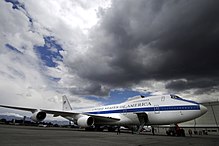Boeing E-4
| Boeing E-4 Nightwatch | |
|---|---|
 Boeing E-4B "Nightwatch" from the USAF |
|
| Type: | Command aircraft |
| Design country: | |
| Manufacturer: | |
| First flight: |
June 13, 1973 |
| Commissioning: |
December 1974 |
| Number of pieces: |
4th |
The Boeing E-4 Advanced Airborne Command Post , also known as Nightwatch or unofficially “doomsday aircraft”, serves the United States Air Force (USAF) as an airborne crisis command post. It is based on the Boeing 747-200B and, as a National Airborne Operations Center (NAOC), is intended to ensure the command and control of the US government and armed forces if the land-based communications infrastructure has already been destroyed by war or natural disasters. Four copies of this aircraft were procured by the USAF in the 1970s.
Development history
Since the USA was exposed to the danger of a nuclear attack on their country during the Cold War , it was decided to transfer the military command on board an airplane in such an emergency in order to maintain the authority for as long and as independently as possible. At the end of February 1973, the USAF initially ordered three E-4A , their maiden flight (still without equipment) took place on June 13, 1973. The first machine was delivered by Boeing in December 1974, the third in the course of 1975. In December 1979, the US Air Force received a fourth E-4B equipped with modern electronics. Its first flight was on June 10, 1978. The A -Models also brought up to date with the latest technology up to 1985 and from then on were called E-4B .
The outer skin of the E-4 offers protection against the electromagnetic impulses that occur in atomic bomb explosions . A wide variety of communication devices are on board, covering all frequency ranges, including satellite radio and broadcasting radio programs to the population. There are also lounges and conference rooms for the military personnel, including the cockpit crew, with up to 63 people; in addition, a maximum of 51 passengers can be carried in a separate compartment.
commitment
During the Cold War, one E-4 was on constant alert. In 2007 the readiness was downgraded and a retirement was initially planned for 2007. However, since there is no replacement with the canceled E-10 , the decommissioning was postponed to 2015. [obsolete] The four Boeing E-4s belong to the arsenal of Air Combat Command (ACC) , 1st Airborne Command Control Squadron (1ACCS) of the 55th Wing at Offutt Air Force Base , Nebraska . It was originally only intended for military purposes, but since 1994 it has also been used for support in the event of natural disasters.
List of E-4
| Type | serial number | USAF registration |
Remarks | |
|---|---|---|---|---|
| 1 | E-4A | 20682/202 | 73-1676 | The first E-4 delivered, still referred to as the Advanced Airborne Command Post (AABNCP) when it was delivered, had its maiden flight on June 13, 1973. The equipment with the reconnaissance and communication systems took place in Greenville, Texas , that same year . In December 1974 the aircraft was stationed at Andrews Air Force Base. Converted to the E-4B standard by 1985. |
| 2 | E-4A | 20683/204 | 73-1677 | Converted to the E-4B standard by 1985. |
| 3 | E-4A | 20684/232 | 74-0787 | Converted to the E-4B standard by 1985. |
| 4th | E-4B | 20949/257 | 75-0125 | Delivered as E-4 B. Rollout on January 27, 1983 |
annotation
- ↑ Version that the aircraft had when it was handed over to the USAF.
- ↑ The first two digits allow conclusions to be drawn about the so-called fiscal year in which the order of the aircraft was decided in the budget report.
Technical specifications

| Parameter | Data |
|---|---|
| length | 70.5 m |
| span | 59.6 m |
| height | 19.3 m |
| Wing area | 511 m² |
| Empty weight | 186 t |
| Maximum takeoff weight | 360 t |
| Top speed | 970 km / h |
| Maximum altitude | > 12,000 m |
| Range (without air refueling ) | approx. 11,000 km |
| Maximum flight time (with in-flight refueling) | 72 hours |
| drive | Four F103-GE-100 with 233.5 kN each |
| Crew (cockpit) | Four (2 pilots, 1 navigator, 1 on-board technician) |
Incidents
On June 16, 2017, two E-4Bs were damaged in a hangar by a tornado at Offutt Air Force Base , Nebraska, USA, as the tail fins protruded. At first nothing is known about the extent of the damage and the future of these two machines.
Web links
Individual evidence
- ^ A b c d e Robert F. Dorr: America's Doomsday Aircraft . Key Publishing, Stamford February 2012, p. 58-63 (English).
- ^ Süddeutsche Zeitung: Offutt Air Force Base: Tornado damages the flying command center of the US Air Force. Retrieved June 24, 2017 .

